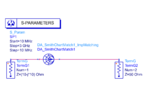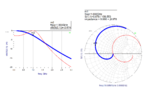ueckid
Member level 1
- Joined
- Mar 22, 2017
- Messages
- 39
- Helped
- 2
- Reputation
- 4
- Reaction score
- 3
- Trophy points
- 1,288
- Location
- Osaka, Japan
- Activity points
- 1,692
Hi all,
I am now designing an output matching network for a PA operating at 5.8 GHz using microstrip lines on a Roger 4350 substrate. In the schematic and EM models, the insertion loss of this network is relatively high (around 0.5 dB in EM model), this should result in significant reduction of output power and efficiency of PA (please see the figure attached). Could anyone please kindly tell me good strategies to reduce insertion loss in design of output matching network using microstrip line for PA design?
Many thanks in advance!
**broken link removed**
I am now designing an output matching network for a PA operating at 5.8 GHz using microstrip lines on a Roger 4350 substrate. In the schematic and EM models, the insertion loss of this network is relatively high (around 0.5 dB in EM model), this should result in significant reduction of output power and efficiency of PA (please see the figure attached). Could anyone please kindly tell me good strategies to reduce insertion loss in design of output matching network using microstrip line for PA design?
Many thanks in advance!
**broken link removed**





